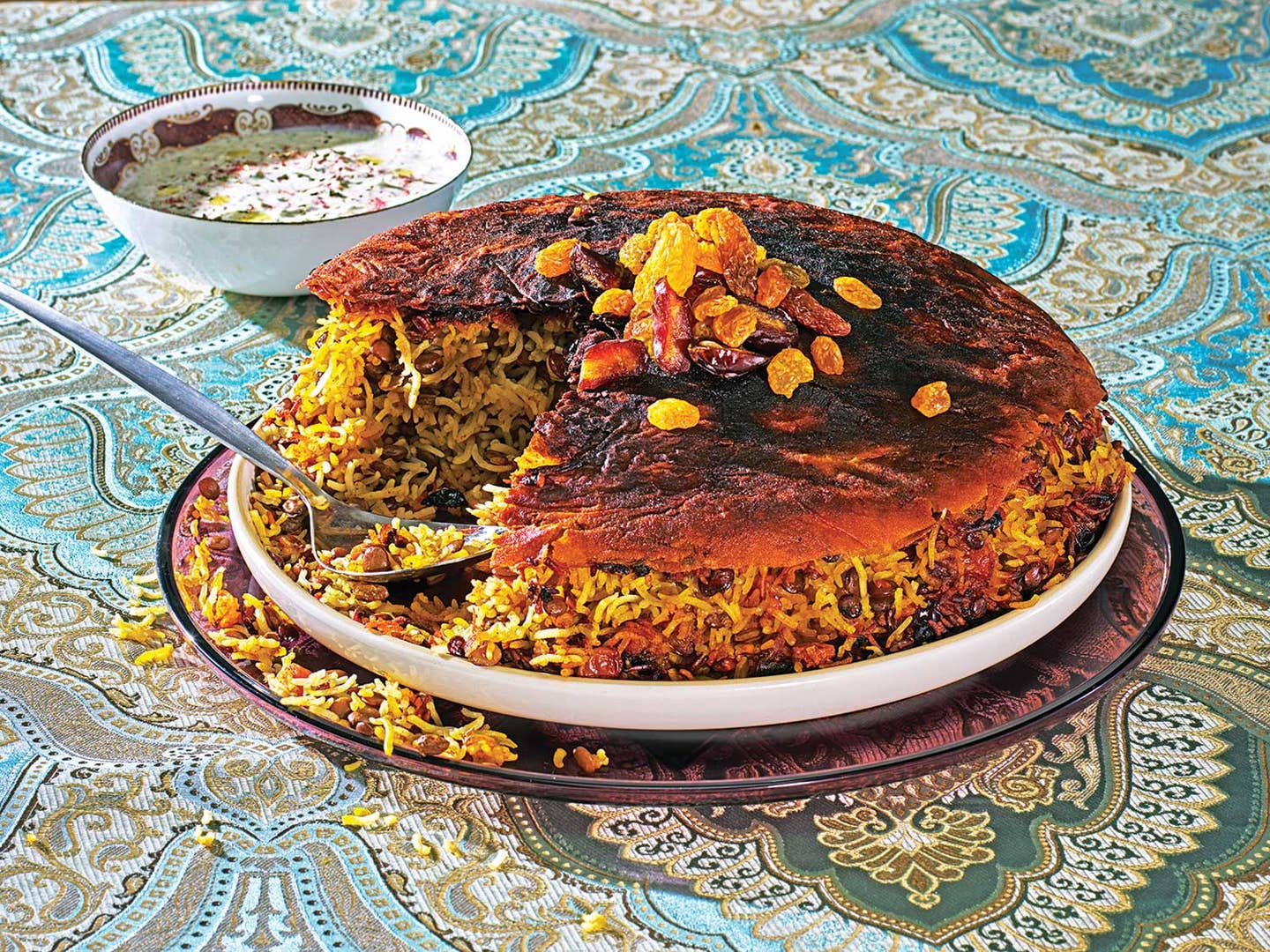
A layer of thin lavash laid between the pot and the rice in this dish acts as a barrier to prevent the dried fruits from burning, and also becomes a crispy, golden-brown bread tahdig. When the rice is unmolded from the pot, you can serve the mixture whole and allow guests to cut or crack into the tahdig on their own, or you can slice it into clean wedges and serve them alongside individual portions of the rice. If desired, you can embellish the lavash with extra dried fruit.
What You Will Need
Ingredients
- 2 cups (13 1/3 oz.) extra-long white basmati rice
- 6 tbsp. plus 1 tsp. kosher salt, plus more as needed
- 1⁄2 tsp. saffron, lightly ground between your fingers
- 1 cup green or brown lentils, picked, rinsed, and drained
- 1⁄4 cup plus 2 Tbsp. clarified unsalted butter, divided
- 1 medium yellow onion, finely chopped (1 cup)
- 6 medjool dates, pitted and coarsely chopped (4 oz.)
- 1 cup (5½ oz.) golden or brown raisins, plus more for garnish if desired
- 1⁄2 tsp. ground cinnamon
- 2 tsp. ground cumin
- One large piece lavash bread
- 1 tbsp. extra-virgin olive oil, plus more as needed
Instructions
Step 1
Step 2
Step 3
Step 4
Step 5
Step 6
Step 7
Step 8
- Parboil the rice by following steps 1 and 2 of the Steamed Saffron Rice with Tahdig recipe. Set aside the rice to drain at room temperature as you prepare the dish’s other components.
- Meanwhile, soak the saffron in ¼ cup plus 3 tablespoons hot water. Set aside.
- In a medium pot, add the lentils, 2 cups cold water, and 1 teaspoon kosher salt. Partially cover the pot and bring to a boil over high heat, then lower the heat to medium-low and cook, stirring occasionally, until all or most of the water has evaporated and the lentils are softened but not completely cooked through, about 20 minutes. (If the lentils are ready but there’s still water in the pot, drain them well; if the water is absorbed but the lentils aren’t ready yet, add a little more water and cook a few minutes longer.) Set aside.
- Meanwhile, in a medium pot, melt 2 tablespoons of clarified butter over medium-high heat; add the onion and cook, stirring occasionally, until softened and golden, about 12 minutes. Lower the heat to medium-low, then add the dates, raisins, cinnamon, and 3 tablespoons of the saffron water. Season with a pinch of salt and cook, stirring occasionally, until the dried fruits have absorbed most of the liquid, about 3 minutes. Remove the pot from the heat and partially cover it; set aside to cool slightly.
- Transfer the drained, parboiled rice to a large bowl; add the lentils, the dried fruit mixture, and the cumin, and stir gently with your hands, taking care not to break the grains. Set this mixture by the stove.
- Cut around the edges of the lavash bread so that it fits the bottom surface of an 8- to 10-inch-wide, shallow, nonstick pot and comes just slightly up the sides. Set the pot over medium heat and add 2 tablespoons of the clarified butter, the olive oil, 1½ teaspoons of the saffron water, and a pinch of salt. As the butter melts, swirl the mixture around so that it evenly covers the bottom of the pot in a thin layer and comes a little up the sides, adding another tablespoon or two of oil as needed to coat the bottom in a very thin layer. Working quickly, press the lavash onto the bottom of the pot, patching any gaping spots with leftover lavash. Gently scatter the rice, lentil, and dried fruit mixture over the bread, mounding it slightly in the center but making sure that the lavash is completely covered with the mixture. With the handle of a wooden spoon, poke a few holes into the rice without hitting the lavash to allow some steam to escape. Cover the pot and cook until you see steam escaping out the sides of the lid, 10–12 minutes.
- Meanwhile, in a small pot, melt the remaining 2 tablespoons of butter and add it to the remaining saffron water. Lift the rice pot lid without dripping the condensation trapped under the lid back into the pot and drizzle the butter-water-saffron mixture over the rice. Wrap the lid in a kitchen towel or a couple of layers of paper towels to catch any condensation, then place the lid firmly back on the pot. (Make sure the kitchen towel or paper towels are secured on top so they don’t catch fire.) Lower the heat to medium-low and cook, rotating the pot a few times for even crisping, until the rice is tender and fluffy and the tahdig is crispy and golden, about 35 minutes. (It’s tricky to check for doneness, but look for the rice on the sides of the pot to appear dry and set.)
- Work quickly to avoid burning the lavash: To serve the rice with lavash on top, place an appropriately sized flat plate over the pot (this will be your serving plate). Take a deep breath, and quickly and confidently flip the pot over. You should hear a swish when the tahdig releases. Remove the pot. Garnish the lavash with extra dried fruit if desired. Use a serrated or sharp knife to cut wedges through the lavash and serve them with the rice portions, if desired. Alternatively, scatter the rice across a platter and serve the tahdig cut into pieces on the side.
Keep Reading
Continue to Next Story










